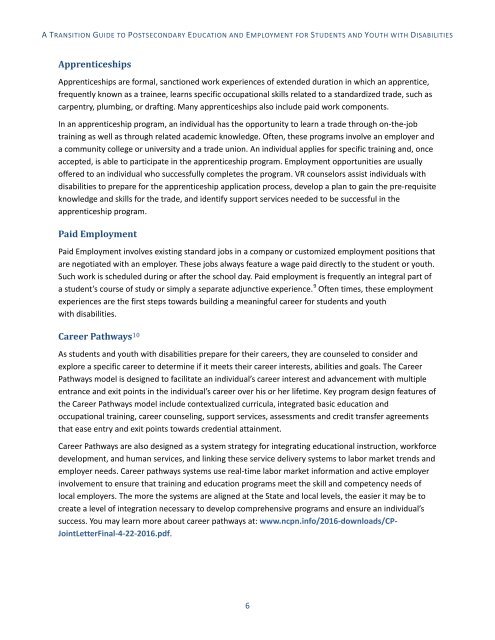TRANSITION GUIDE
2j9tM4H
2j9tM4H
Create successful ePaper yourself
Turn your PDF publications into a flip-book with our unique Google optimized e-Paper software.
A <strong>TRANSITION</strong> <strong>GUIDE</strong> TO POSTSECONDARY EDUCATION AND EMPLOYMENT FOR STUDENTS AND YOUTH WITH DISABILITIES<br />
Apprenticeships<br />
Apprenticeships are formal, sanctioned work experiences of extended duration in which an apprentice,<br />
frequently known as a trainee, learns specific occupational skills related to a standardized trade, such as<br />
carpentry, plumbing, or drafting. Many apprenticeships also include paid work components.<br />
In an apprenticeship program, an individual has the opportunity to learn a trade through on-the-job<br />
training as well as through related academic knowledge. Often, these programs involve an employer and<br />
a community college or university and a trade union. An individual applies for specific training and, once<br />
accepted, is able to participate in the apprenticeship program. Employment opportunities are usually<br />
offered to an individual who successfully completes the program. VR counselors assist individuals with<br />
disabilities to prepare for the apprenticeship application process, develop a plan to gain the pre-requisite<br />
knowledge and skills for the trade, and identify support services needed to be successful in the<br />
apprenticeship program.<br />
Paid Employment<br />
Paid Employment involves existing standard jobs in a company or customized employment positions that<br />
are negotiated with an employer. These jobs always feature a wage paid directly to the student or youth.<br />
Such work is scheduled during or after the school day. Paid employment is frequently an integral part of<br />
a student’s course of study or simply a separate adjunctive experience. 9 Often times, these employment<br />
experiences are the first steps towards building a meaningful career for students and youth<br />
with disabilities.<br />
Career Pathways 10<br />
As students and youth with disabilities prepare for their careers, they are counseled to consider and<br />
explore a specific career to determine if it meets their career interests, abilities and goals. The Career<br />
Pathways model is designed to facilitate an individual’s career interest and advancement with multiple<br />
entrance and exit points in the individual’s career over his or her lifetime. Key program design features of<br />
the Career Pathways model include contextualized curricula, integrated basic education and<br />
occupational training, career counseling, support services, assessments and credit transfer agreements<br />
that ease entry and exit points towards credential attainment.<br />
Career Pathways are also designed as a system strategy for integrating educational instruction, workforce<br />
development, and human services, and linking these service delivery systems to labor market trends and<br />
employer needs. Career pathways systems use real-time labor market information and active employer<br />
involvement to ensure that training and education programs meet the skill and competency needs of<br />
local employers. The more the systems are aligned at the State and local levels, the easier it may be to<br />
create a level of integration necessary to develop comprehensive programs and ensure an individual’s<br />
success. You may learn more about career pathways at: www.ncpn.info/2016-downloads/CP-<br />
JointLetterFinal-4-22-2016.pdf.<br />
6


